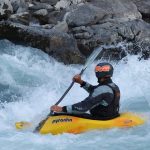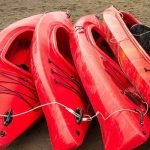If you desire a fun way to motivate your children to appreciate the natural environment, kayaking is an ideal activity to introduce them to.
Kayaking is typically not an extremely tough sport, so even young kids are capable of going on brief kayak excursions either on their own or with a companion. Paddling on multiple rivers and streams makes it less probable for them to become fed up.
No doubt, kayaking with children differs from kayaking with an adult. It takes more planning.
This guide provides all the necessary information required to safely paddle with your children.
PLANNING YOUR TRIP
Careful preparation is essential if you wish to have a successful experience when engaging in any type of outdoor activity.
Here are the key elements you should keep in mind when setting up a kayaking journey with youngsters.
At What Age Can Children Start Kayaking?
How old the kid is, how physically capable they are, and your own kayaking expertise are all considerations when taking a youngster out kayaking. However, we’ll use ages to simplify this explanation.
Some veteran paddlers may elect to take young children as copilots in double kayaks. It is not suggested to practice duffing with a toddler unless they are able to remain in the same position for an extended amount of time and have the ability to stay afloat on their back wearing a personal flotation device.
You’ll need someone experienced in handling the back of the kayak who can manage it on their own, if needed. Additionally, you should be able to take care of yourself and your toddler in case the kayak flips over.
Youths in between four to eight years are ideal for going out on a tandem kayak ride if they can remain stationary for a sufficient period. Duffing is an amazing initiation activity for youngsters to take up kayaking, while allowing them to utilize their own kid-proportioned paddle in order to familiarize themselves with the rudiments of paddling.
Children aged eight and above may possess the physical strength necessary to paddle the bow of a boat.
When Can a Child Start Kayaking in Their Own Kayak?
Some children learn to use small kayaks from as early as three or four years of age. However, at this stage, drill will mainly include grasping the paddle and rowing for a brief period of time.
If you’d like your child to become a proficient swimmer, beginning their practice between the ages of five and seven is optimal. An appropriate setting would be in a pool or any other still body of water. Children aged seven and under may be able to keep paddling in a tiny kayak for a distance of between 0.25 and 0.5 miles.
Young children seven years or older should be able to manage a kayak of reduced size, similar to if they were riding with someone else in a tandem kayak. By the time a child has reached this age, they will typically have the capability to focus for a long period of time, as well as the ability to use their physical strength to paddle a kayak for roughly half a mile to a mile.
Getting Kids Enthusiastic About Kayaking
If you are keen for your offspring to possess an enthusiasm for kayaking, then discuss it with them. Maybe you can tell each other stories about your most remarkable experiences whitewater kayaking, or watch films involving canoeing to spark their enthusiasm.
You can motivate them by allowing them to experience sitting in a kayak, whether it be at home or in a kayaking shop. If they are the appropriate age, you might consider signing them up for a kayaking program.
Once they have expressed an interest, work together with your child to map out the route so they are part of every aspect of the trip. Provide ideas for trips that would be enjoyable for them. Think about letting them bring a pal along if you have another grown-up who can help out with monitoring.
Where to Go Kayaking with Kids
Remain in placid waters until your kid has gained significant skill in kayaking. Consider sluggish streams, ponds, tiny lakes, or maybe a secure cove. Paths with a lot of different kinds of activities are preferable so that your children do not become bored.
If you don’t know the best spots for kayaking with children, perhaps your local kayaking club could provide useful tips.
When your kid is sure of themselves in a kayak and can do the primary paddle strokes, extract themselves from the water correctly, and knows how to remain safe, it’s possible for you to go explore rivers with a faster current, larger bodies of water, or alongside shorelines.
When to Go Kayaking with Kids
Young people are more prone to getting cold than grown-ups, so it is of paramount importance to take into account the temperature of the air and water before going kayaking. Venturing onto the water with your child during the wintertime is not recommended, regardless of if they are wearing sufficient cold-weather clothing.
Children are more likely to get sunburns than adults. You should wear a sunhat and sunscreen for protection, but try to paddle earlier in the day or in the evening when the sun is not so strong. Pick a river or lake with lots of trees and shade to go canoeing in during the afternoon.
Bodies of water such as canals, ponds, and lakes that are surrounded by trees may provide some degree of shade.
Think about installing a bimini sun shade on your kayak if you will be using it in the afternoon.
Length of Trip
It is recommended to keep kayaking excursions limited in duration due to the fact that numerous children have difficulty maintaining a stationary position over time and become quickly bored. Younger children should not spend longer than thirty minutes on the water.
Older children could have the potential to go on trips lasting up to an hour, depending on their physical strength, how long they can pay attention, and their familiarity with rowing.
A strategy to kayak with children for the entire day without them becoming bored or fatigued is to schedule rest stops. You could break up your paddling activity by spending around half an hour or one hour paddling, then take a pause for a swim, paddle for a further span of around half an hour or one hour, then make a lengthy picnic stop.
If your children are rowing a boat, a rest period will help them to regain their strength. If your children are taking a ride in a double kayak, the gaps in between will give them a chance to be active and expend some of their energy.
Bodies of water like lakes and streams in rural areas that have plenty of places to launch boats are perfect for this kind of experience.
Can You Kayak With Children?
Yes. It is possible to go kayaking with a kid who is aged between four and seven. Having a baby with you while kayaking can be a great experience, but you must be ready to address the difficulties that come with taking a child along.
Particularly when using a sit-on-top kayak, you should be aware that there will always be some amount of water pooling on the bottom of the boat. This implies that there will be no spot in which your infant can take refuge, instead they will permanently remain held by you.
Children ranging in ages from 4 to 7 years old can function properly in a kayak. It is believed that they are mature and powerful enough to remain still on the front of the boat. However, they cannot provide propulsion.
You will need to expend more energy to row, which will cut down on the amount of ground you regularly travel by kayak when by yourself.
Kids of four years old may be able to manage the stern of a tandem kayak with the paddle, though they can’t paddle independently yet. Kids aged 5 and 6 can begin to use a paddle, but don’t expect them to generate much thrust. It also depends on the child and kayak.
Important Things To Know When Kayaking With a Child
Taking a baby out kayaking can heighten the possibility of an unfavorable incident occurring. Only attempt this activity if you have previous experience paddling or have someone knowledgeable accompanying you. Make sure the kid is able to swim or has a personal flotation device (PFD) on.
Be sure to keep your kayak in an area that is secure and well-guarded when you have an infant with you. Don’t explore unsafe kayaking locations with a kid. Think about the weather, including rain and storms, before you go anywhere with your baby.
The following advice can help to keep you and your baby safe when you go kayaking.
Age: How Old Should a Child Be To Go In a Kayak?
Young infants are not equipped to tolerate the rough weather outdoors as their immune systems are still in the process of developing. Make the health of your little one the priority over any kayaking opportunity, no matter how attractive it might be.
Wait till the perfect moment to demonstrate to your infant what your kayaking world is all about.
Destinations: Where to Paddle
It would not be safe to bring your infant to any kayaking spot. Certain areas are too hazardous for the child and escalates the possibility of an unforeseen incident occurring.
Find a secure area for your infant with decreased hazard. Optimal waters are preferable, yet you can also investigate serene waters. Rough or turbulent water with powerful flows is not secure for any young person.
Types of Kayaks: Sit-in or Sit-on/ Single or Tandem?
Your baby becomes the second person in your kayak. Thus, opt for a kayak that has a compartment that can accommodate them. You should make sure your infant doesn’t spend too much time in the kayaks’ water pools.
What is the best kind of kayak to use if you want to go paddling with your infant?
You can have your child sit in the front or back portion of the boat until they are experienced enough to paddle it alone. The center pocket has been made to carry your things, not your infant.
This item is not resistant to the occasional splash of water, but it will be protected in peaceful waters.
Learn Skills Beforehand
Have you ever taken your child kayaking before? If the answer is affirmative, you should take action rather than simply making plans for your journey.
Take the opportunity to instruct your child on wet exits, bracing, and other essential safety methods. It can be beneficial in the event of an emergency.
Gaining some expertise can help guarantee that your journey is successful. This will help your child to be mentally ready for this aquatic activity. You and your child can take swimming and kayaking classes to help you both when you start going in the water.
Show your child some enjoyable physical activities and make sure they understand how to get into a kayak if they happen to fall out.
Children who are above the age of 7 ought to be prepared to maneuver the front of a canoe or kayak and get acquainted with some paddling strategies. You can help them practice them before the trip.
Safety Gear
Be ready for any situation and stay optimistic while taking your child kayaking. You should not disregard any worries regarding safety.
Obtain protective equipment that is certified by the American Coast Guard. Adhere to the manufacturer’s usage and sizing guidelines. PFDs are sized for weight ranges as follows:
- Infants (8-30 lbs.)
- Children (30-50 lbs.)
- Youth (50-90 lbs.)
The safety gear you need includes the following:
- Lines and Floats
- Sunglasses that are well-liked and fit well.
- Emergency whistles.
- Seat pads or short seats for a low center of gravity.
- Spray decks and skirts (cover the open compartment areas).
- Tow/throw rope.
- Personal maps and compasses
One might observe that the protective equipment will assist you in responding to any circumstance and preserve a life. An emergency whistle can be used to issue a plea for aid if you are in need of assistance from other paddlers in a kayak. Maps and compasses help you with navigation.
Personalize The Trip to The Baby’s Interests
Encourage your child to take part in the kayaking trip rather than forcing it on them. Distribute the maps, photos, and stories about previous kayaking trips to excite the child about the upcoming outing. Have the child invite a companion to make it even more enjoyable.
Once the child agrees to join on the journey, involve them in packing and give them praise for the hard work they put in. The main point is to ensure that the child is included in the journey.
Food and Water
Kayaking excursions can be really draining for those who participate. This experience can be hard on your child if it is their first time. Bringing food to furnish power and drinking water to rehydrate is the outcome.
Calculate how long the journey will take in order to determine how much food and water to bring. Think of nutritious food options that are effortless to transport and make sure to always have water accessible. Make sure the child gets enough liquid intake throughout the day.
Clothing
It’s best to plan your kayaking trip for a day when the weather is predicted to be nice, so that it won’t be interrupted by rain or storms. Be sure to keep an eye or ear out for the weather report to get an idea of how the weather will be on your designated day.
Pack spare outfits in a water-resistant sack in the event you need to switch. For children younger than seven years old, include extra trousers.
Also, carry a wide-brimmed hat for rain and sun. The powerful heat of the sun can lead to exhaustion prior to reaching the halfway point of a journey.
Tips:
- Apply sun protection
- Bring some fun toys




